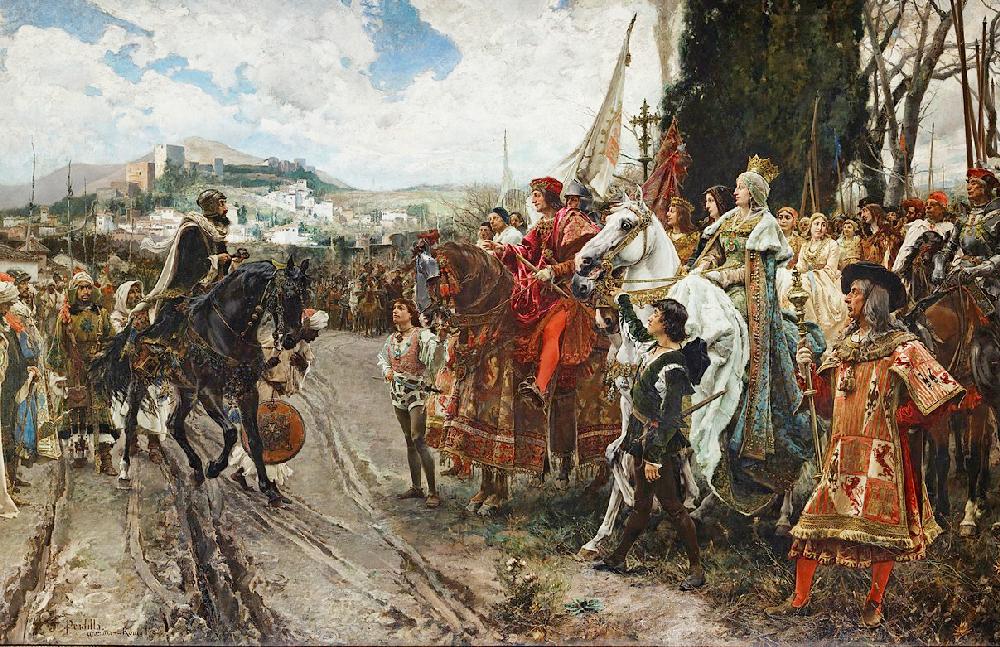
Spanish Reconquista: Fall of Granada (1492)

Figure 1.--This depiction of the Rendición de Granada (Surrender of Grenada was commissiined bt the Spanish Senate (1879). The artist was Francisco Pradilla Ortiz, perhaps the most prolific of Spanish artists. Heis best known for his historical themes. Unlike his many costumbristas, this work took 3 years to complete.
|
|
The Granada War (Guerra de Granada) was the last campaign of the Reconquista (1482-92). Like much of the Reconquita it was not 10 years of constant fighting, but a series of military campaigns beginning in 1482. The fighting was generally conducted only in the Spring and Summer. The Catholic monarchs (Isabella I of Castile and Ferdinand II of Aragon) wage war against the Nasrid dynasty's Emirate of Granada--the last Muslim stronghold in Spain. The Emirate's effort were hampered by interrnal divisions The Spanish were able to weaken the Emirate economically. As a result, of past defeats, the Emirate was having to pay tribute to Spain. The Spanish had begun to acquire artillery that the Emirate could not counter. This resulted in victories that earlier would have meant long, costly seiges. Finally, Muhammad XII of Granada (King Boabdil) surrendered the Emirate of Granada, the city of Granada, and the Alhambra palace to the Castilian forces. The Spanish victory ended the convivencia ("live and let live") that had characterized the relations between the the faiths of Iberia. These chnges were led by the Inquisition that had been established decades earlier. The Jews were forced to convert to Christianity or be exiled (1492). The terms of Granada's surrender garnteed toleration to Muslims -- the Alhambra Decree Treaty. The city's Muslim inhabitants, known as Mudéjars, were to be allowed to practice of their faith and traditiinal customs. Cardinal Francisco Jiménez de Cisneros a major figure in the Spanish church and state and Grand Inquisitor, assumed that the Muslims when exposed to the True Faith would quickly abandon Islam. This did not happen. As a result, the first archbishop of Granada, Hernando de Talavera, adopted a program of forced Christian baptisms, creating the Converso (convert) class for Muslims and Jews. Granada's Muslims were forced to convert to Christianity, become slaves, or be exiled. This approach gradually spread to the rest of Spain. The New Christians (conversos) were eventually accused of crypto-Islam and crypto-Judaism. Spain would model its national aspirations as the guardian of Christianity and Catholicism and eventually lead the Catholic camapign against the Protesant Reformation.
CIH

Navigate the Childrem in History Website:
[Return to The Reconquista]
[Return to Main early war page]
[Return to Main medieval page]
[Re[Introduction]
[Biographies]
[Chronology]
[Climatology]
[Clothing]
[Disease and Health]
[Economics]
[Geography]
[History]
[Human Nature]
[Law]
[Nationalism]
[Presidents]
[Religion]
[Royalty]
[Science]
[Social Class]
[Bibliographies]
[Contributions]
[FAQs]
[Glossaries]
[Images]
[Links]
[Registration]
[Tools]
[Children in History Home]
Created: 1:40 AM 7/15/2013
Last updated: 11:28 PM 7/16/2013



